 International Journal of Modern Nonlinear Theory and Application, 2013, 2, 153-160 http://dx.doi.org/10.4236/ijmnta.2013.23020 Published Online September 2013 (http://www.scirp.org/journal/ijmnta) Approximate Controllability of Fractional Order Retarded Semilinear Control Systems Simegne Tafesse1, Nagarajan Sukavanam2 1Department of Mathematics, Haramaya University, Dire Dawa, Ethiopia 2Department of Mathematics, Indian Institute Technology Roorkee (IITR), Roorkee, India Email: wtsimegne@gmail.com Received June 4, 2013; revised July 6, 2013; accepted July 25, 2013 Copyright © 2013 Simegne Tafesse, Nagarajan Sukavanam. This is an open access article distributed under the Creative Commons Attribution License, which permits unrestricted use, distribution, and reproduction in any medium, provided the original work is properly cited. ABSTRACT In this paper, approximate controllability of fractional order retarded semilinear systems is studied when the nonlinear term satisfies the newly formulated bounded integral contractor-type conditions. We have shown the existence and uniqueness of the mild solution for the fractional order retarded semilinear systems using an iterative procedure ap- proach. Finally, we obtain the approximate con trollab ility results of the system under simple condition. Keywords: Approximate Controllability; Fraction a l Order; Existence and Uniqueness, Retarded; Semilinear System; Integral Contractor 1. Introduction Let X and U be Hilbert spaces with the corresponding function spaces 20, : L X and 20, :YL U respectively. Consider the following fractional order se- milinear system ,,0 ,,0 Cq t DxtAxtButftxt xh t (1.1) where is the fractional order qth derivative in Cq t Dx Caputo’s sense, 11 2q , A is the infinitesimal genera- tor of a Co-semigroup T(t) of bounded linear op erator on the Hilbert space X, B is a bounded linear operator from , f is a nonlinear function such that YZ :0, ,0: Ch XX , :,0 t hX is de- fined as for t,0 xt ,0:Ch Xh and . The norm in X shall be denoted by .. The corresponding linear fractional order system is given by ,0 ,,0 Cq t DxtAxt Butt xh (1.2) Fractional differential equations are the generalization of ordinary differential equations of arbitrary non integer orders. The fractional calculus is widely popular in the field of engineering and sciences, Shantanu [1]. Debnath [2] studied the recent applications of fractional calculus to dynamical systems in control theory, electrical circuits with fractance, generalized voltage divider, viscoelastic- ity etc. Many papers have appeared on the controllability concepts for fractional order differential systems. For instance, Wang and Zhou [3] studied complete controlla- bility of fractional evolution systems. In that paper frac- tional calculus method and fixed point theorem are used. The semigroup operator is assumed to be noncompact. Similarly controllability of fractional order impulsive neutral functional infinite delay integrodifferential sys- tems in Banach space is studied by Tai and Wang [4]. Sakthivel et al. [5] discussed the controllability of a class of control systems governed by the semilinear fractional equations in Hilbert spaces using fixed point techniques. Kumar and Sukavanam [6] studied approximate control- lability of fractional order semilinear systems with bounded delay. In that paper contraction principle and Schauder fixed point theorem are used. Zhou and Jiao [7] and El-Borai [8] studied the existence of mild solutions for fractional neutral evolution systems. The notion of integral contractor was first introduced by Altman [9] and later on it was used by many authors to study the existence and uniqueness of solution of nonlinear evolution systems. In [10] George et al. studied the existence and uniqueness of the solution and the con- trollability of the nonlinear third order dispersion equa- C opyright © 2013 SciRes. IJMNTA 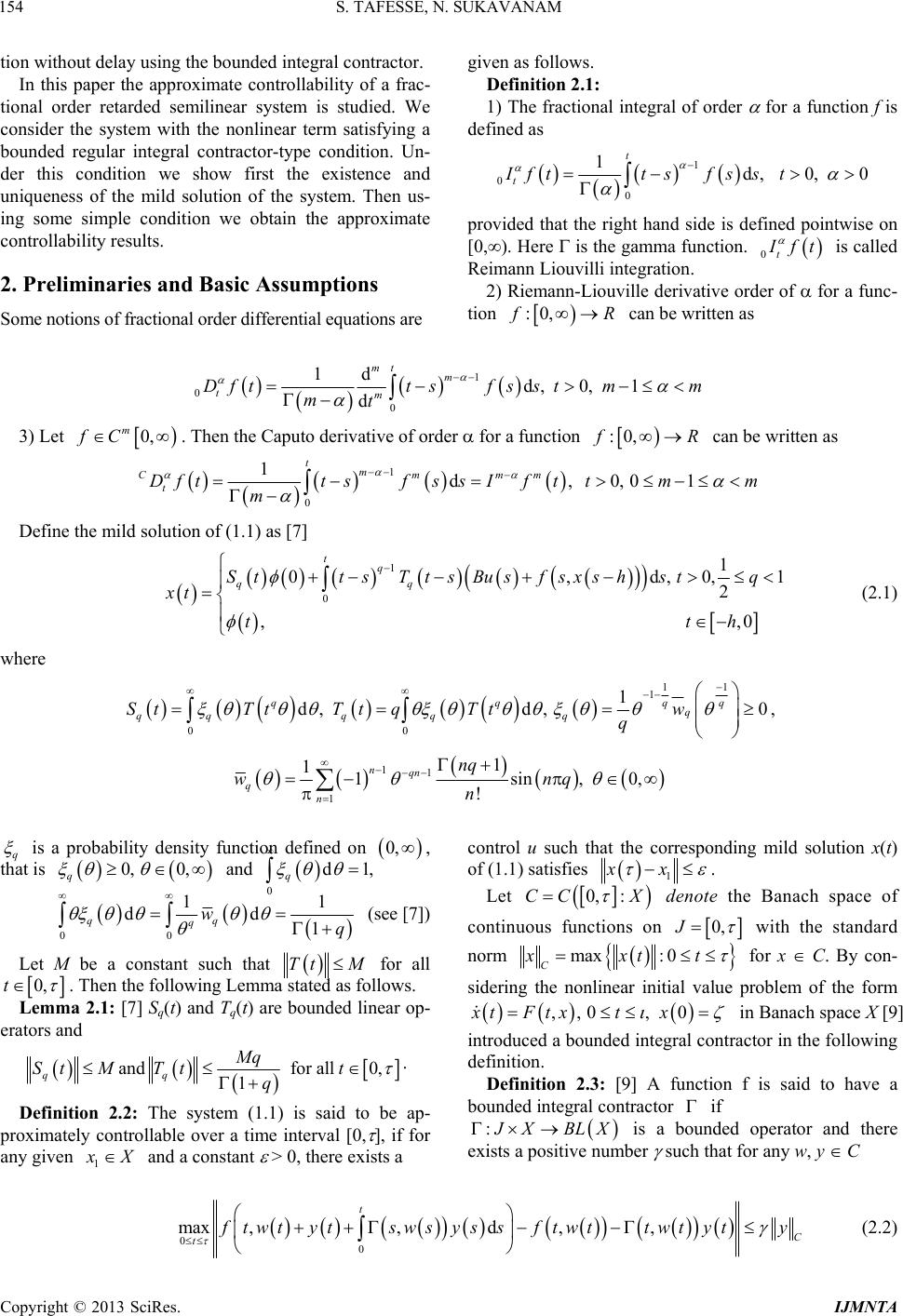 S. TAFESSE, N. SUKAVANAM 154 tion without delay using the bounded integr al contractor. In this paper the approximate controllability of a frac- tional order retarded semilinear system is studied. We consider the system with the nonlinear term satisfying a bounded regular integral contractor-type condition. Un- der this condition we show first the existence and uniqueness of the mild solution of the system. Then us- ing some simple condition we obtain the approximate controllability results. 2. Preliminaries and Basic Assumptions Some notions of fractional order differential equations are given as follows. Definitio n 2 .1: 1) The fractional in tegral of order for a function f is defined as 1 00 1d, 0, 0 t t Ifttsfsst provided that the right hand side is defined pointwise on [0,). Here is the gamma function. 0t ft is called Reimann Liouvilli integr ation. 2) Riemann-Liouville derivative order of for a func- tion :0, R can be written as 1 00 1d d, 0,1 d t mm tm Dftt sfsstmm mt 3) Let . Then the Caputo derivative of order for a function 0, m fC :0, R can be writte n as 1 0 1d,0,01 tm Cmmm t Dftt sfssIfttmm m Define the mild solution of (1.1) as [7] 1 0 1 0,d 2 ,, tq qq SttsTtsBus fsxshstq xt tt ,0,1 0 h (2.1) where 11 1 00 1 d, d,0 qq qq q qqq qq StTtTt qTtw q , 11 1 1 11sin, ! nqn qn nq wn n 0,q q is a probability density functio defined on n 0, , that is and 0, 0, q 0 d1 q , 00 11 dd 1 qq qwq (see [7]) Let M be a constant such that Tt M for all 0,t . Then the following Lemma stated as follows. Lemma 2.1: [7] Sq(t) and Tq(t) are bounded linear op- erators and andfor all0, 1 qq q St MTtt q . Definition 2.2: The system (1.1) is said to be ap- proximately controllable over a time interval [0, ], if for any given 1 X and a constant > 0, there exists a control u such that the corresponding mild solution x(t) of (1.1) satisfies 1 xx . Let 0, :CC X denote the Banach space of continuous functions on 0,J with the standard norm max :0 C xxtt for x C.By con- sidering the nonlinear initial value problem of the form ,,0, 0xt Ftxtx in Banach space X [9] introduced a bounded integral contractor in the following definition. Definition 2.3: [9] A function f is said to have a bounded integral contractor if : XBLX is a bounded operator and there exists a positive number such that for any w, y C 00 max ,,d,, t C t twtytswsyssf twttwtyty (2.2) Copyright © 2013 SciRes. IJMNTA  S. TAFESSE, N. SUKAVANAM 155 Definition 2.4: [9] A bounded integral contractor is said to be regular if the integral equation 0 ,d t ztytsws yss (2.3) has a solution y in C fo r ever y w, z C. We define a bounded integral contractor operator q for the fractional order system without delay in a similar fashion as: Definition 2.5: Suppose : q XBLX is a bounded operator and there exists a positive number such that for any w, y Z we have 1 0 ,,d,, tqqq q twtytt sTt sswsyssftwttwtytyt (2.4) Then we say that f has a bounded integral contractor with respect to the operator Tq(t). q Definition 2.6: A bounded integral contractor q is said to be regular if the integral equation 1 0 , tqq q ztyttsTt sswsyss has a solution y in Z for every w, z Z. Let us assume 1 ,, q LB X twttJ wZ d (2.5) Let 2,: h LhX . Now we define a new bounded integral contractor-type operator so as to make compatible with retarded system as follows. q h Definition 2.7: Let :, q hh h CBLCX be such that for ,0h 1 0 ,d,0 0, ,0 tqq qhss q ttt tsTtsswyst wy th (2.6) If for any w, y Zh ,,, qq th twt hythwytftwt htwt h yt hyt , (2.7) then f is said to have an integral contractor-type operator q h . It can be seen easily if , then 0 q h 0 q h and f is Lipschitz continuous. Let us assume that 2 , ,,, h qtw ht h LB CXtJ wZ and 12 max , . Similar to Equation (2.5) con- sider the integral equation of the form 1 0 ,d, 0,, , ,0 tqq tqhss t ytsTtsswystzw z tt tth C h (2.8) Definition 2.8: If is bounded and the integral Equation (2.8) has a solution yt in Ch for every zt, wt Ch, then is called regular on Ch. q h q h Now we assume the following conditions: 1) The semigroup T(t), t 0, is compact and T(t) = 0 for t [–h,0) 2) f has a bounded regular integral contractor-type q h on Ch i.e. ,,, qq tttttthtt t twyw yftwtw yy 3) f is uniformly bounded, i.e. there exists M1 > 0 such that 1 ,t ftx M 4) The fractional order linear system corresponding to (1.1) is approximate controllable 5) For all y Y there exists a constant k>0 such that Byky Lemma 2.2: [7] If the assumption (1) is satisfied, then q St and q Tt are also compact operators for every t>0. 3. Main Result Define the solution mapping W: Y Z by Wu = x where x(t) is the unique mild solution of (1.1) corresponding to Copyright © 2013 SciRes. IJMNTA 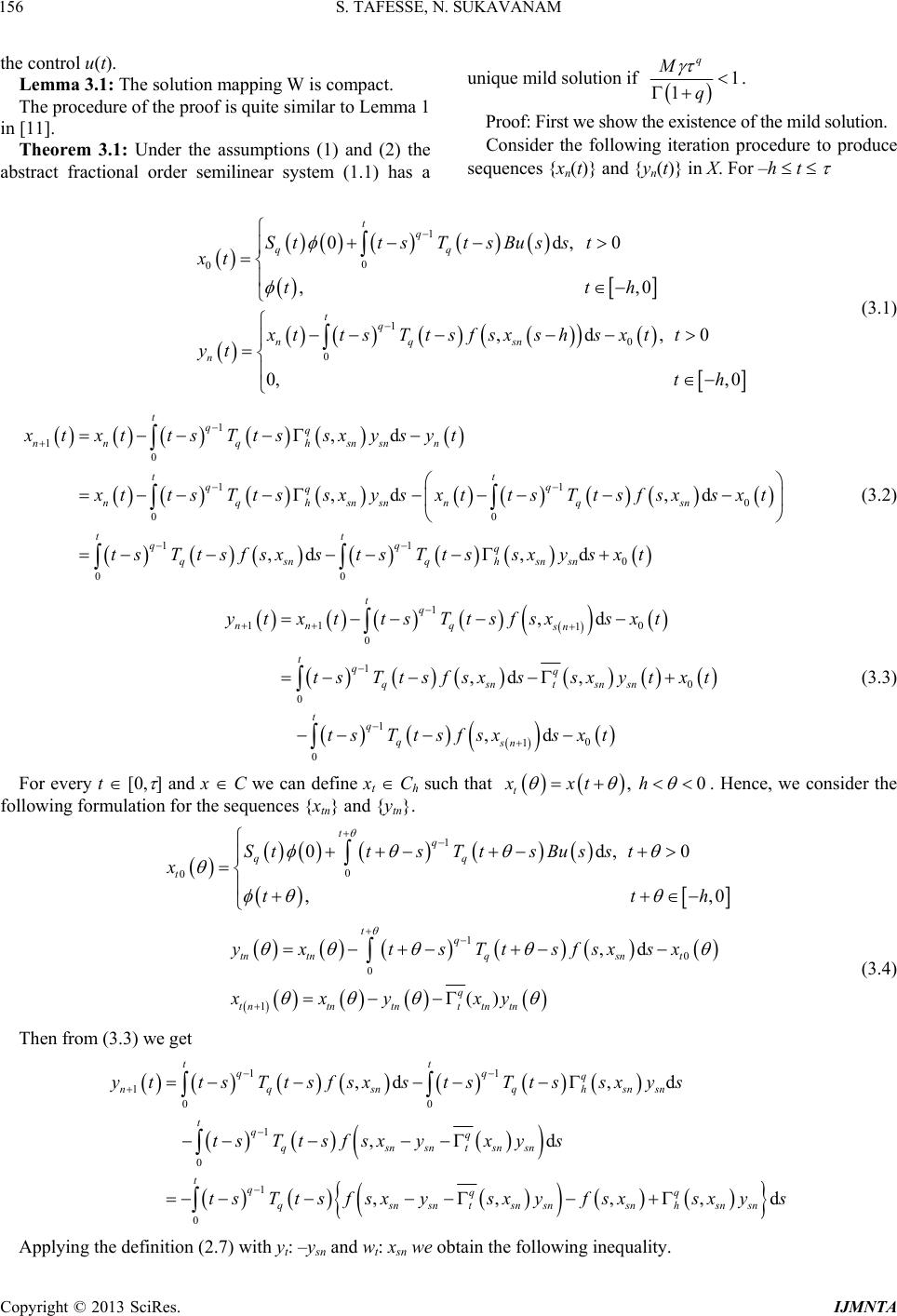 S. TAFESSE, N. SUKAVANAM 156 the control u(t). Lemma 3.1: The solution mapping W is compact. The procedure of the proof is quite similar to Lemma 1 in [11]. Theorem 3.1: Under the assumptions (1) and (2) the abstract fractional order semilinear system (1.1) has a unique mild solution if 1 1 q M q . Proof: First we show the existence of the mild solution. Consider the following iteration procedure to produce sequences {xn(t)} and {yn(t)} in X. For –h t 1 0 0 1 0 0 0d,0 ,, ,d,0 0, ,0 tq qq tq nqsn n Stts TtsBusst xt tt xttsTtsfsx shsxtt yt th 0h (3.1) 1 10 11 0 00 11 0 00 ,d ,d ,d ,d, d tqq nnqhsn snn tt qq q nqhsnsnnqsn tt qq q qsn qhsnsn xtxttsTts sxysyt ttsTt ssxysxttsTtsfsxsxt t sTt sfsxst sTt ssxys xt (3.2) 1 11 0 1 0 1 0 0 1 0 1 0 ,d ,d , ,d tq nnq sn tqq qsntsn sn tq qsn ytxttsTtsfsxsxt tsTtsfsxssxy txt ts Ttsfsxsxt (3.3) For every t [0, ] and x C we can define xt Ch such that , 0 t xxth . Hence, we consider the following formul ation for the sequences {xtn} and {ytn}. 1 0 0 0d ,, tq qq t Stts TtsBusst x tt ,0 0h 1 0 0 1 ,d () tq tntnqsn t q tntnttn tn tn yx tsTtsfsxsx xxy xy (3.4) Then from (3.3) we get 11 100 1 0 1 0 ,d, d ,d ,,,, tt qq q nqsnqhsnsn tqq qsnsntsn sn tqqq qsnsntsn snsnhsn sn y tts TtsfsxstsTtssxys tsTtsfsxyxys tsTtsfsxysx yfsxsx ys d Applying the definition (2.7) with yt: –ysn and wt: xsn we obtain the following inequality. Copyright © 2013 SciRes. IJMNTA 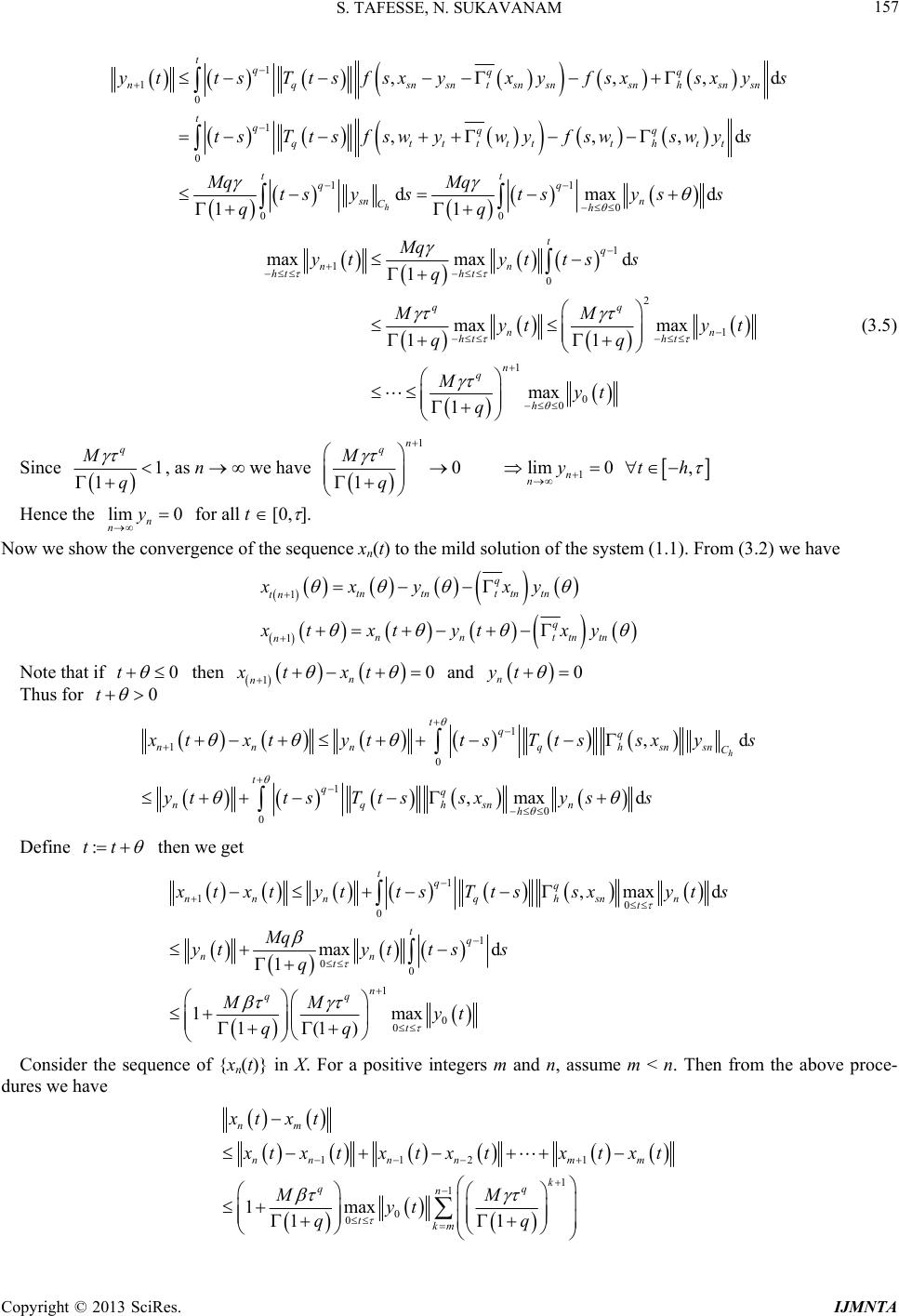 S. TAFESSE, N. SUKAVANAM 157 1 10 1 0 11 0 00 ,, ,,, dmax 11 h tqqq nqsnsntsn snsnhsn sn tqqq qtttttthtt tt qq sn n Ch yttsTtsfsxyxyfsxsxys tsTtsf swywyfswswys Mq Mq ts ystsyss qq ,d d d 1 10 2 1 1 0 0 maxmax d 1 max max 11 max 1 tq nn ht ht qq nn ht ht n q h Mq ytyt tss q MM ytyt qq Myt q (3.5) Since 1 1 q M q , as n w e ha ve 1 1 0lim0 1 n q n n Myth q , Hence the for all t [0, ]. lim 0 n ny Now we show the convergence of the sequence xn(t) to the mild solution of the system (1.1). From (3.2) we have 1 1 q tntnttntn tn q nn ttntn n xxyxy xtxt ytxy Note that if 0t then 10 n n xt xt and 0 n yt t Thus for 0 1 10 1 0 0 ,d ,max d h tqq nn nqhsnsn C tqq nqhsnn h txt yttsTtssxy ytts Ttssxyss s Define :tt then we get 1 10 0 1 00 1 0 0 ,max d max d 1 1max 1(1) tqq nn nqhsnn t tq nn t n qq t txtytts Ttssxyts Mq ytyt tss q MM yt qq Consider the sequence of {xn(t)} in X. For a positive integers m and n, assume m < n. Then from the above proce- dures we have 112 1 1 1 0 0 1max 11 nm nnn nm m k qq n tkm xt xt txtxtx txtxt MM yt qq Copyright © 2013 SciRes. IJMNTA 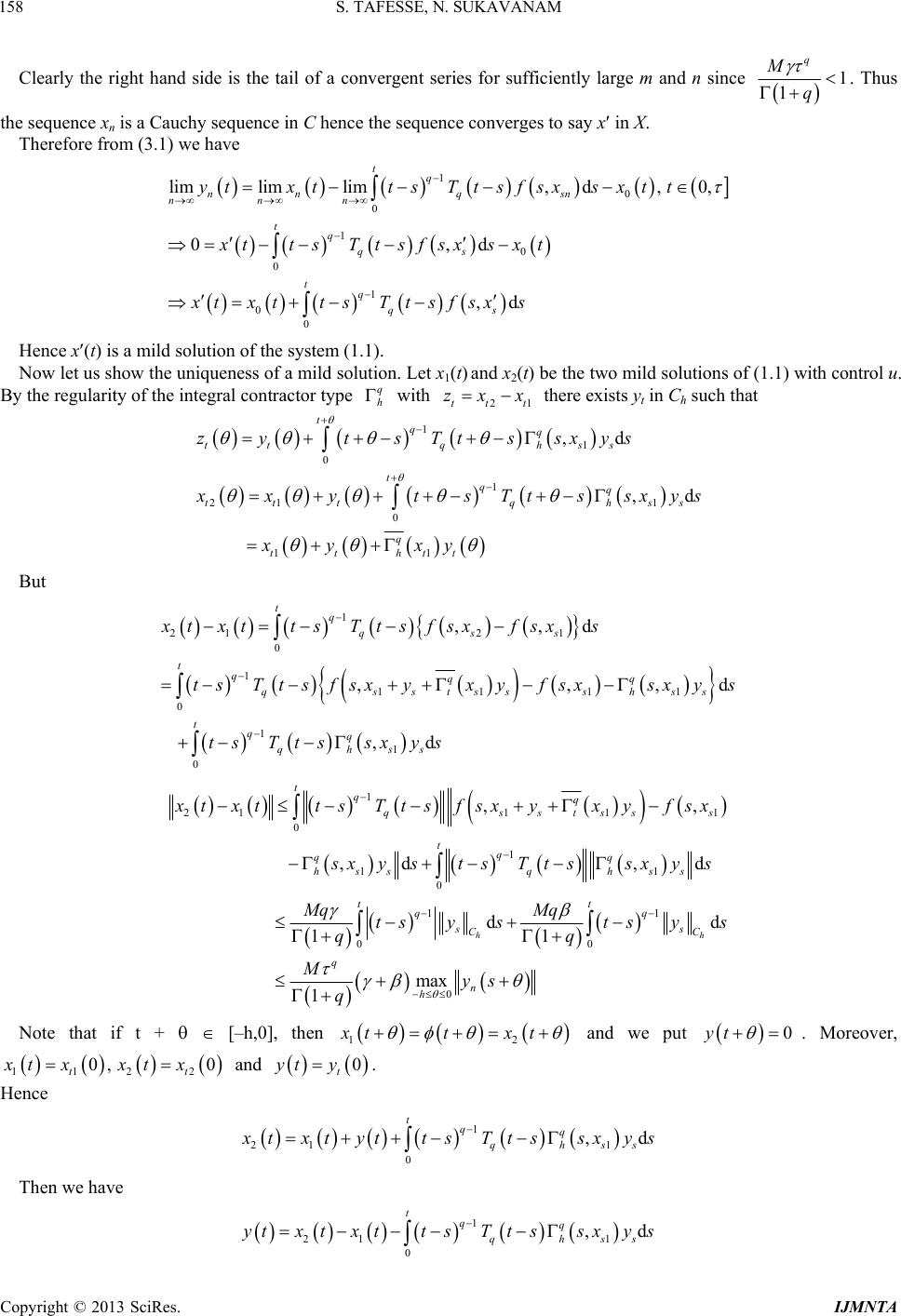 S. TAFESSE, N. SUKAVANAM 158 Clearly the right hand side is the tail of a convergent series for sufficiently large m and n since 1 1 q M q . Thus the sequence xn is a Cauchy sequence in C hence the sequence converges to say x in X. Therefore from (3.1) we have 1 0 0 1 0 0 1 00 limlimlim, d,0, 0,d ,d tq nnq sn nnn tq qs tq qs ytxtts Ttsfsxsxtt xtt sTt sfsxsxt xtxtt sTt sfsxs Hence x(t) is a mild solution of th e system (1.1). Now let us show the uniqueness of a mild solution. Let x1(t) and x2(t) be the two mild solutions of (1.1) with control u. By the regularity of the integral co ntractor type q h with 2tt t zxx 1 there exists yt in Ch such that 1 1 0 1 21 1 0 11 ,d ,d tqq ttq hss tqq tttqhs q tthtt zy tsTtssxys s xy tsTtssxy xy xy s But 1 212 1 0 1 11 11 0 1 1 0 ,,d ,, ,d tq qss tqqq qsstssshs tqq qhss xtxttsTts fsxfsxs tsTtsfsxyx yfsxsxys tsTtssx ys ,d s 1 211 1 0 1 11 0 11 00 0 ,, ,d ,d dd 11 max 1 hh tqq qsstss tq qq hssq hss tt qq ss CC q n h 1 s txtt sTt sfsxyxyfsx xystsTtssxys Mq Mq tsys tsys qq Mys q Note that if t + [–h,0], then 1 xtt xt 2 0 t y and we put . Moreover, and . 0yt 112 2 0, 0 tt xt xxt x yt Hence 1 21 1 0 ,d tqq qhss txtyttsTts sxy s s Then we have 1 211 0 ,d tqq qhs ytxtxttsTt ssxys Copyright © 2013 SciRes. IJMNTA 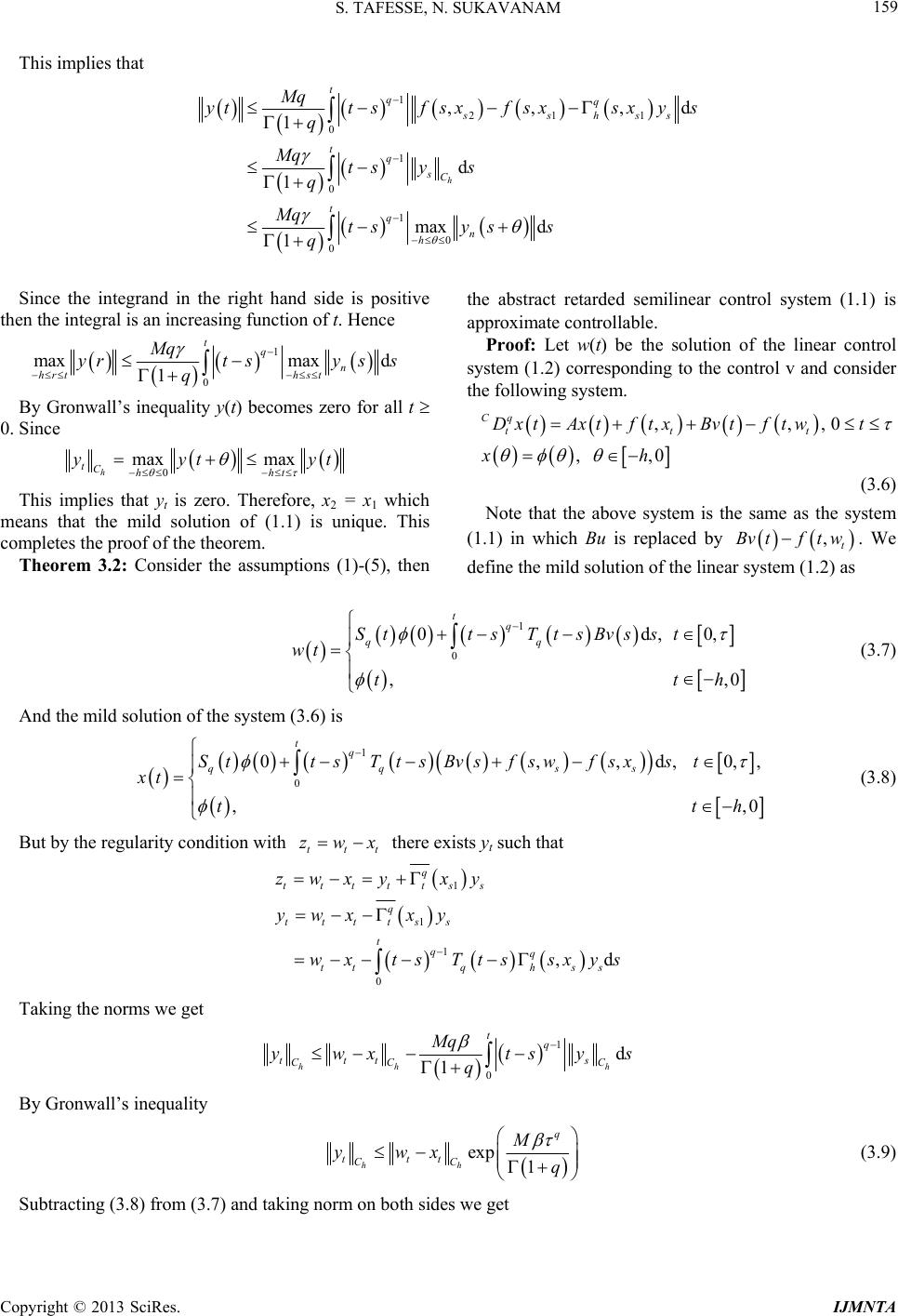 S. TAFESSE, N. SUKAVANAM Copyright © 2013 SciRes. IJMNTA 159 This implies that 1 21 1 0 1 0 1 0 0 ,, , 1 d 1 max d 1 h tqq sshs tq sC tq n h Mq yttsf sxfsxsxys q Mq ts y s q Mq tsys s q d s Since the integrand in the right hand side is positive then the integral is an increasing function of t. Hence the abstract retarded semilinear control system (1.1) is approximate controllable. Proof: Let w(t) be the solution of the linear control system (1.2) corresponding to the control v and consider the following system. 1 0 maxmax d 1 tq n hrt hst Mq yrtsy ss q By Gronwall’s inequality y(t) becomes zero for all t 0. Since ,,,0 ,,0 Cq ttt DxtAxtftxBvt ftwt xh (3.6) 0 max max h tChht yt yt This implies that yt is zero. Therefore, x2 = x1 whic h means that the mild solution of (1.1) is unique. This completes the proof of the theorem. Note that the above system is the same as the system (1.1) in which Bu is replaced by ,t Bvtftw. We define the mild solution of the linear system (1.2) as Theorem 3.2: Consider the assumptions (1)-(5), then 1 0 0d ,, tq qq Stts TtsBvsst wt tt ,0, 0h (3.7) And the mild solution of the system (3.6) is 1 0 0,, ,, tq qq ss SttsTtsBvsfswfsxs t xt tt d,0,, 0h (3.8) But by the regularity condition with there exists yt such that tt zwx t 1 1 1 0 ,d q tttttss q ttttss tqq ttqh ss zwxy xy ywx xy wxtsTtssxys Taking the norms we get 1 0 d 1 hh tq ttt s CC Mq h C wxts y s q By Gronwall’s inequality exp 1 hh q ttt CC M ywxq (3.9) Subtracting (3.8) from (3.7) and taking norm on both sides we get 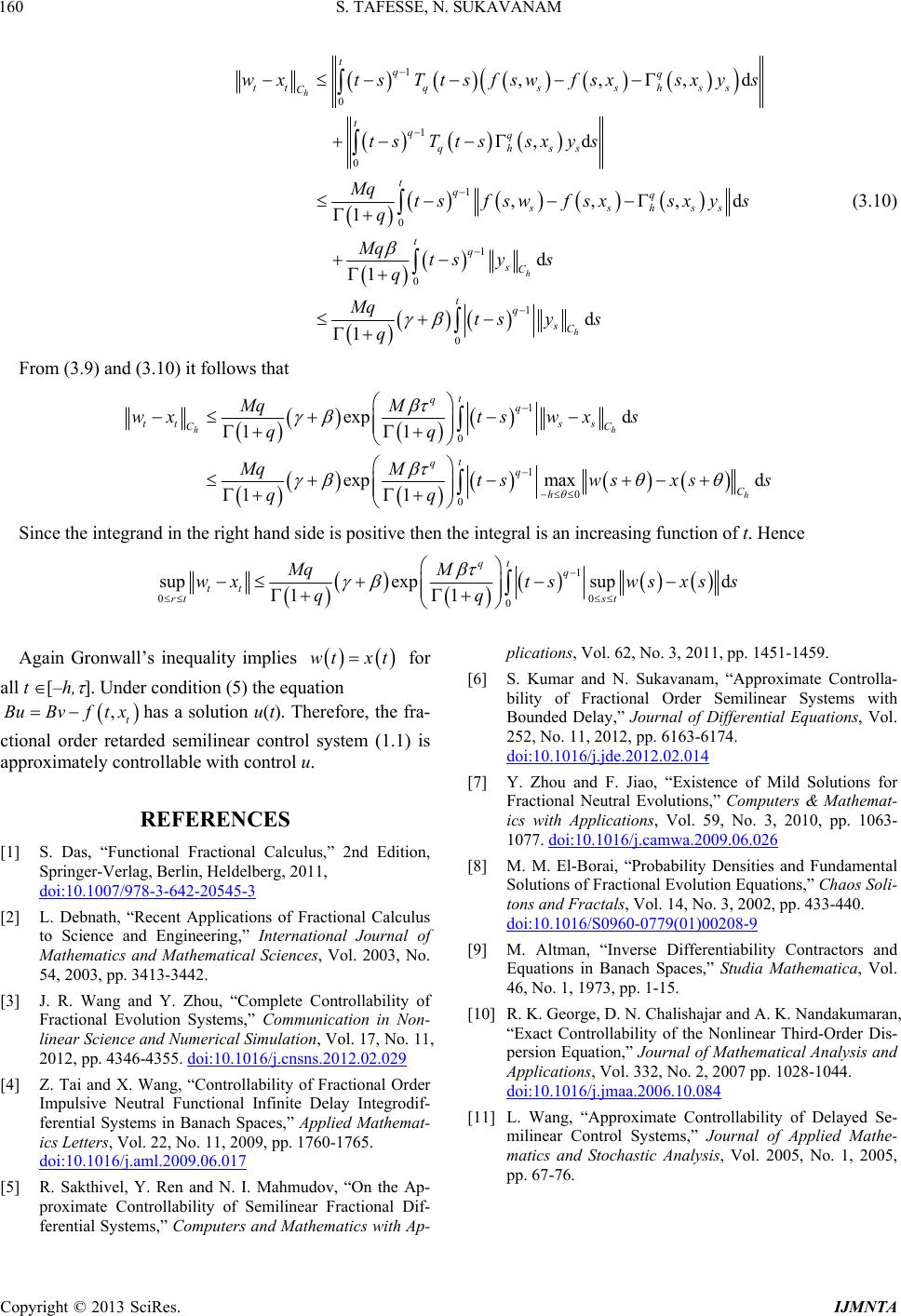 S. TAFESSE, N. SUKAVANAM 160 1 0 1 0 1 0 1 0 1 0 ,, , ,d ,, , 1 d 1 d 1 h h h tqq ttqssh ss C tqq qhss tqq sshss tq sC tq sC wxtsTtsfswfsxsxy s ts Ttssxys Mq tsf swfsxsxys q Mq ts ys q Mq ts y s q d d (3.10) From (3.9) and (3.10) it follows that 1 0 1 0 0 exp d 11 exp maxd 11 h h h t qq tt ss C C t qq C h Mq M wxts wxs qq MqM tsws xss qq Since the integrand in the right hand side is positive then the integral is an increasing function of t. He nce 1 0 0 0 supexpsup d 11 t qq tt rt st Mq M wxts wsxss qq Again Gronwall’s inequality implies wt xt for all t [–h, ]. Under condition (5) the equation has a solution u(t). Therefore, the fra- ctional order retarded semilinear control system (1.1) is approximately controllable with control u. ,t BuBvft x REFERENCES [1] S. Das, “Functional Fractional Calculus,” 2nd Edition, Springer-Verlag, Berlin, Heldelberg, 2011, doi:10.1007/978-3-642-20545-3 [2] L. Debnath, “Recent Applications of Fractional Calculus to Science and Engineering,” International Journal of Mathematics and Mathematical Sciences, Vol. 2003, No. 54, 2003, pp. 3413-3442. [3] J. R. Wang and Y. Zhou, “Complete Controllability of Fractional Evolution Systems,” Communication in Non- linear Science and Numerical Simulation, Vol. 17, No. 11, 2012, pp. 4346-4355. doi:10.1016/j.cnsns.2012.02.029 [4] Z. Tai and X. Wang, “Controllability of Fractional Order Impulsive Neutral Functional Infinite Delay Integrodif- ferential Systems in Banach Spaces,” Applied Mathemat- ics Letters, Vol. 22, No. 11, 2009, pp. 1760-1765. doi:10.1016/j.aml.2009.06.017 [5] R. Sakthivel, Y. Ren and N. I. Mahmudov, “On the Ap- proximate Controllability of Semilinear Fractional Dif- ferential Systems,” Computers and Mathematics with Ap- plications, Vol. 62, No. 3, 2011, pp. 1451-1459. [6] S. Kumar and N. Sukavanam, “Approximate Controlla- bility of Fractional Order Semilinear Systems with Bounded Delay,” Journal of Differential Equations, Vol. 252, No. 11, 2012, pp. 6163-6174. doi:10.1016/j.jde.2012.02.014 [7] Y. Zhou and F. Jiao, “Existence of Mild Solutions for Fractional Neutral Evolutions,” Computers & Mathemat- ics with Applications, Vol. 59, No. 3, 2010, pp. 1063- 1077. doi:10.1016/j.camwa.2009.06.026 [8] M. M. El-Borai, “Probability Densities and Fundamental Solutions of Fractional Evolution Equations,” Chaos Soli- tons and Fractals, Vol. 14, No. 3, 2002, pp. 433-440. doi:10.1016/S0960-0779(01)00208-9 [9] M. Altman, “Inverse Differentiability Contractors and Equations in Banach Spaces,” Studia Mathematica, Vol. 46, No. 1, 1973, pp. 1-15. [10] R. K. George, D. N. Chalishajar and A. K. Nandakumaran, “Exact Controllability of the Nonlinear Third-Order Dis- persion Equation,” Journal of Mathematical Analysis and Applications, Vol. 332, No. 2, 2007 pp. 1028-1044. doi:10.1016/j.jmaa.2006.10.084 [11] L. Wang, “Approximate Controllability of Delayed Se- milinear Control Systems,” Journal of Applied Mathe- matics and Stochastic Analysis, Vol. 2005, No. 1, 2005, pp. 67-76. Copyright © 2013 SciRes. IJMNTA
|